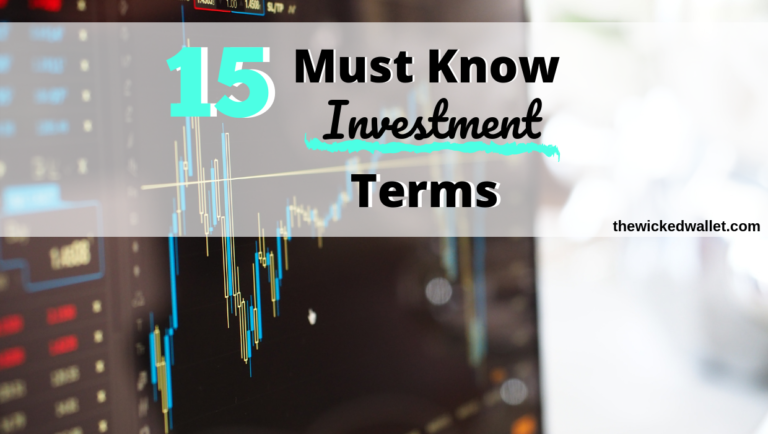If you’re new to investing then this article is for you. The language of finance and investing can be an intimidating language for newcomers. Understanding this language in layman’s terms will allow you to have a better chance at financial success. Investment lingo can be difficult to understand and may even deter some from investing. These 15 must know investment terms will improve your general knowledge of the industry. In this article, I’m going to cover these 15 Must Know Investment Terms and explain them as simply as possible.
If your looking to learn something then buckle up as we begin deep dive into the 15 must know investment terms, first up is asset allocation.
Asset Allocation
As you do your research, you will start seeing asset allocation thrown around a lot. On the surface, this may seem complex but this is simply how your investment portfolio is divided up. Your asset allocation is also a reflection of your investment strategy. For instance, an aggressive investor would have a very different asset allocation compared to a less aggressive investor.
Index Fund
Index funds are mutual funds that track certain market indexes such as the S&P 500. A market index is a group of securities in a certain market segment. The S&P 500 for example is an index that tracks the performance of 500 large capitalization stocks.
Index funds typically have less fees since they are designed to mirror certain indexes and are not actively managed. Some more examples of index funds are:
- Vanguard Total Stock Market Index (VTSMX)
- Schwab U.S. Small Cap ETF (SCHA)
- Vanguard High Dividend Yield ETF
For more information in index funds check out this article, “Everything You Need to Know About Index Funds & ETFs”.
Mutual Fund
When you invest in a mutual fund you are investing in a portfolio of assets that is actively managed by a fund manager. The fund manager selects all of the portfolio investments. The advantage/disadvantage of having a fund actively managed is that they may or may not beat the market. Also, having an active manager means more expenses be charged to you to pay for the manager which are taken out of your total returns.
Stocks
A stock is part ownership of a specific corporation. That ownership gives you rights towards that corporations earnings and direction. There are two types of stock that can be issued, common stock and preferred stock.
Common Stock
With common stock you receive part ownership of the company, as well as voting rights. If the company pays out dividends you will be paid out after preferred stock shareholders
Preferred Stock
With preferred stock you receive part ownership, but no voting rights. However, if/when the company pays out dividends the preferred stock shareholders get paid out first.
Bonds
When you buy a bond you are giving the issuer of the bond a loan. In turn the issuer agrees to pay you back that amount plus interest at a set date in the future. The United States government issues and buys bonds to help direct the economy.
Buying a US Treasury Bond is a fairly low risk investment but returns a low yield. Investing in bonds is a great way to diversify your portfolio and reduce the overall risk. The downside is you won’t receive the higher potential earnings from other “riskier” investments.
Prospectus
A prospectus is a report issued by corporations to the public that shares information about the company. The point of a prospectus is to give you the potential investor an idea of what the company does and how they have been performing.
If you are thinking about buying individual stocks then be sure to do your research. The company prospectus is a great source of information. However, it’s important to look at more than just the prospectus to get the full picture.
Dividends
A dividend is a payment received by the shareholder from the business. Typically, dividends are a form of profit distribution. Paying out dividends keeps investors happy because they are receiving payment and the company / investment is doing well.
Exchange Traded Funds
Also known as ETFs, these funds allow you to invest in a portfolio of assets that is bought and sold like an individual stock. Investing in an ETF allows you to have part ownership in a number of assets without having to buy each one individually. This in turn will diversify your portfolio and reduce risk.
For more on ETFs check out this article, “Everything You Need to Know About Index Funds & ETFs”.
Real Estate Investment Trusts (REIT)
A REIT is a company that owns a large real estate portfolio. This can include residential and commercial real estate. When you invest in a REIT you are purchasing part ownership of the property in the portfolio. Therefore, just like a stock you are entitled to the company’s earnings, in this case rent collected or property sold.
Return On Investment (ROI)
One of the formulas that you will want to remember is return on investment. The ROI formula will show you what percentage you earned or lost on an investment. This equation can even be used to calculate potential ROI which may in turn impact your investment decisions. The ROI formula goes as such:
(New price - Old Price / Old price) *100 = ROI
If you buy a stock for $100 and a year later the price per share (pps) is $150 and you decide to sell then your ROI is 50% [(150-100 / 100) *100].
Understanding ROI will help you decide your investment strategy and ideally keep you out of bad investments.
Volatility
Is the riskiness of an investment moving away from its market price. A well established corporation that’s been around for awhile may not be as volatile as say a new tech corporation.
The Company’s beta formula will show it’s volatility compared to the market. A beta of 1.0 shows that this stock is in line with the market. A beta over 1.0 shows a stock that is volatile and moves up and down with the stock market. For example if you have a beta of 2 and the market goes up by 1 point then you can expect your stock to go up by 2, and vice versa.
A stock that is more volatile will have a higher potential ROI is all goes right. However if things don’t go right then you’ll be more exposed to loss. Understanding investment volatility will assist you with your asset allocation.
401K
A 401K is an employer sponsored tax advantaged retirement account. Most full-time employers offer a 401K program that allows you to invest a portion of your paycheck into retirement funds. Many employers even offer a contribution match so be sure to take full advantage of that. As of 2019 you are allowed to contribute up to $19,000 annually to your 401K. The earlier you start saving for retirement the happier your future self will be.
For information regarding 401k distribution rules you can check out the IRS web page here.
403(b)
A 403(b) is the same thing as a 401K except it’s only for educators and non profits. The 403(b) has the same contribution limits and withdrawal penalties. Again the only difference is the group of individuals that it’s available to.
For more information about retirement accounts check out this post: “The 5 Most Important Retirement Accounts That You Need“.
Individual Retirement Account (IRA)
An IRA is similar to 401k however it is not sponsored by your employer. Like a 401k an IRA is a tax advantaged account. As of 2019 the annual contribution for an IRA is $6,000.
You may be wondering if you can have both a 401k and an IRA and the answer is YES! Depending on how much your earn you ideally want to be able to max out the contribution limits for both retirement contributions. This will allow you to take full advantage of the tax benefits and allows you to prepare for retirement.
Closing Thoughts
The world of investing can seem like a really intimidating and honestly it is often over complicated with nonsensical jargon. As with a lot of things, the trick is to self educate and learn as much as you can about investments that spark your interest. The 15 investment terms are only scratching the surface. If you are just getting into investing then I am glad you are here. Starting with the basics and learning the finance world language will allow you to navigate with more ease and confidence.
Learning about investment terminology is a great first step in your path to success. Being able to understand the words that you are reading or hearing will allow you to make more educated decisions. Just remember that education is continuous. Hope you learned something about these 15 investment terms. If you have any comments or questions hit us up in the comment section below, or tap here.
Want to keep learning? Check out these articles:










